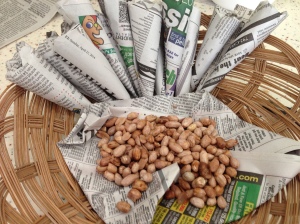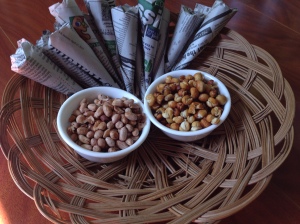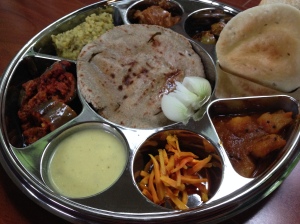
Daal,bhat,shak,rotli.
The above dishes feature in our weekly menu. In fact this khati/meethi dal is probably made at least once a week in many gujarati homes. We are very partial to it as it is tangy, sweet, spicy and nutritious at the same time. Made with boiled, liquidised toor dal this dal is best served piping hot with a bowl of rice. A lot of the spices used in this dal have healing properties, and it packs some protein as well. In our home we usually have this for lunch. We love how the dal combines well with rice (plain boiled), rotli and most curries. Manu adores dal bhat and for us this is a fuss free, meal partaken with a couple of spoonfuls of home made dahi, papad and a small side salad. They say, a well made dal makes for a great day and it is so true. The fragrant aroma of this dal, whilst it bubbles away on the stove fills the home and almost embraces you. Indulge in this piping hot dal is and get a hug in a bowl.
In this post I am sharing my recipe for the above mentioned dal and a simple cauliflower sabji. This sabji or shak takes a bit of prep time but it is well worth using only fresh cauliflower and NOT the frozen stuff. I say this because the florets need to be properly trimmed, the thick stalks (which can also be used) must be chopped into small pieces to enable the vegetable to cook evenly and absorb the spices. If this chopping process is not followed through you will find that the stalks won’t cook and the florets will turn to mush. More importantly, this curry does not entail adding water to create a sauce, the method of cooking this is by placing a plate of water over the simmering pot of cauliflower and let the veg cook in the drops of condensation as the pot simmers away.
Rotli – this pretty much accompanies most curries in our house. Made from wholewheat flower (ground medium to fine) these thinly rolled out flatbreads are best served warm however, these taste delish at room temperature during tea time with pickles and tea.
Here is how all of the above is made and I do hope that you will enjoy this comforting, warm spicy meal.

2 cups cauliflower florets
1 medium tomato ( finely chopped)
1 tea sp salt
3/4 tea sp turmeric powder
1 1/4 tea sp chili powder
1 tea sp dhana jeeru
TEMPERING
5 tab sp oil
1/2 tea sp mustard seeds
1/2 tea sp cumin seeds
pinch asafetida
Heat the oil in a sauce pan ,once heated add the mustard seed, cumin seeds and asafetida. when they start to crackle add the cauliflower florets and soute well. Add the above spices let it cook for 2 to 3 minutes while stirring occasionally. Once done turn off the heat.

Daal
1 cup tuwer daal
2 1 /2 cups water
Temparing
2 table spoons ghee
1 table spoon oil
1 stick cinnamon
3 cloves
1/2 tea spoon cumin seeds
1/2 tea spoon mustard seeds
1/4 tea spoon fenugreek seeds
pinch asafetida
Few curry leaves
2 tomatoes finely chopped
2 tea spoons sugar
1 tea spoon lemon juice
Wash the lentils and drain. Add 2 1/2 cups water and pressure cook 3 whistle. Once done, blend daal until totally liquidized. In a sauce pan add ghee and oil once heated add the above ingredients, When it stars to crackle add grated tomatoes stir for couple minutes add the spices salt,chili powder turmeric powder ,when the oil stars to ooze out add the liquidized daal and bring to boil.Add sugar and lemon juice then let it simmer gently for about 15 min . If its too thick can add litter water. Garnish with cilantro. Enjoy!!
0.000000
0.000000



 2 pieces finely chopped mogo 1 tea spoon salt 1 1/2 tea spoon chili powder 1 table spoon lime joice hand full chopped cilantro hand full roasted pea nuts. Mix all together and enjoy.
2 pieces finely chopped mogo 1 tea spoon salt 1 1/2 tea spoon chili powder 1 table spoon lime joice hand full chopped cilantro hand full roasted pea nuts. Mix all together and enjoy.










